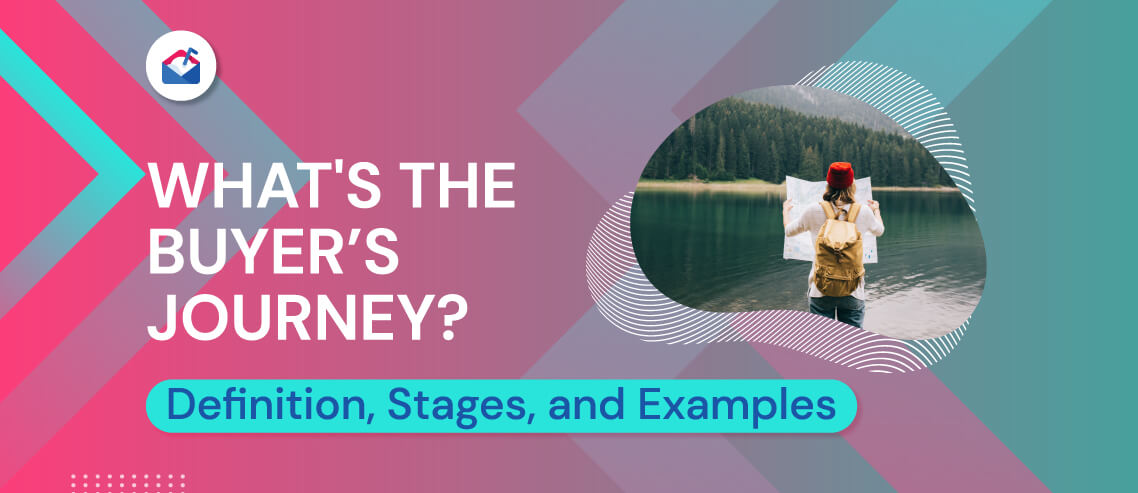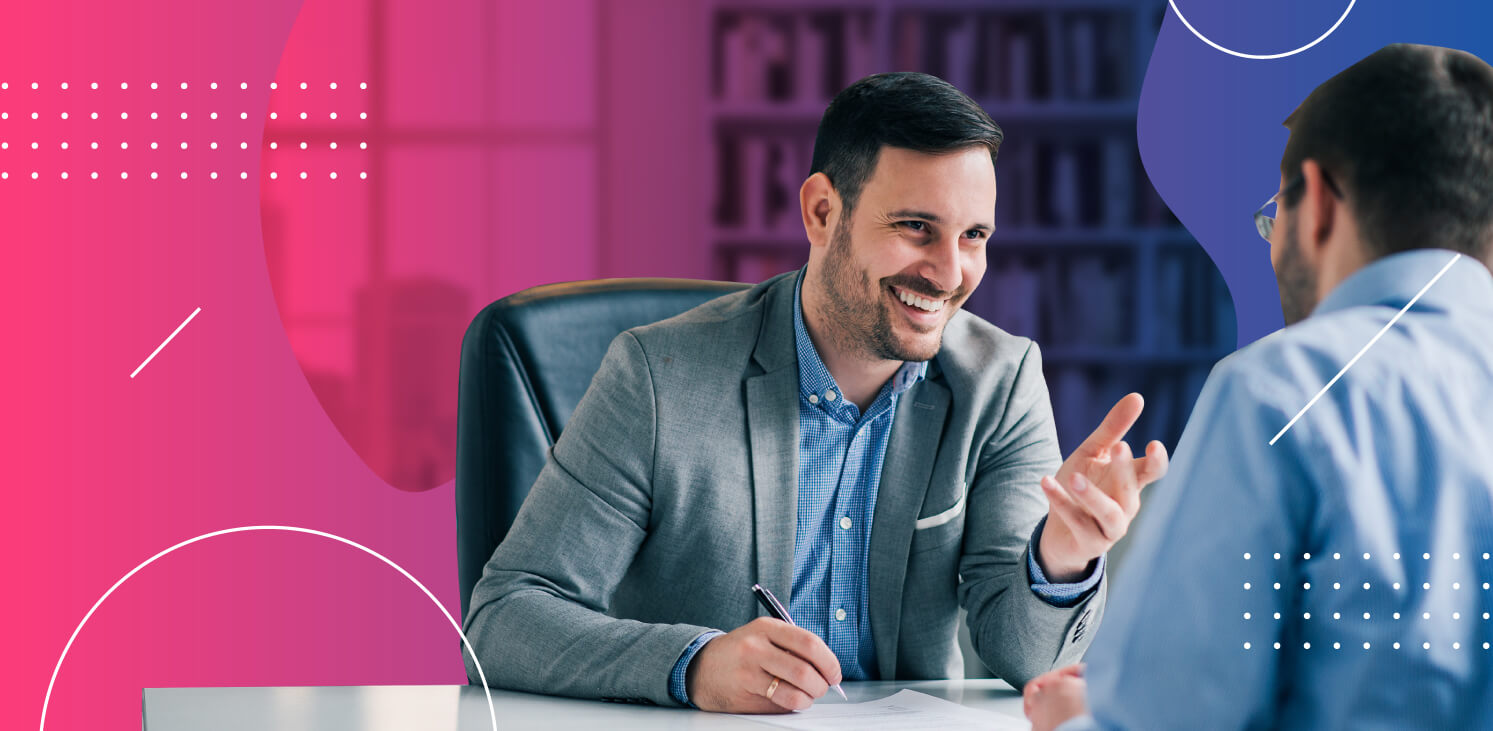What’s the Buyer’s Journey? Definition, Stages, and Examples

Contents
Your buyers don’t just turn up at your door with money in hand ready to buy your product. Instead, they go on a (sometimes complicated) journey that eventually leads to them making a purchase.
Understanding the buyer’s journey is a great way to make your sales process more efficient while also improving the customer experience. With a clear buyer’s journey, you can ensure your customers get what they’re looking for every step of the way.
What’s the Buyer’s Journey?
The buyer’s journey is simply the steps someone goes through before making a purchase.
How often do you discover a brand new product and buy it there or then? The chances are it’s not very often. In fact, in some industries, it’s suggested it takes an average of eight touchpoints to get an initial meeting.
The buyer’s journey tracks the steps your customers take to becoming a customer and even beyond. It’s split up into four stages: awareness, consideration, decision, and delight.
Understanding the buyer’s journey is important because it allows you to serve prospects with the information they need at each stage of the process. For example, when you’ve just learned about cold outreach, you want different information from when you’re comparing the best cold email platforms.
The buyer’s journey is a way to visualize the steps your customers take so you can help progress them through the journey.
What Are the Stages of the Buyer’s Journey?
A traditional buyer’s journey is split into four stages. At each stage in the journey, the buyer wants something slightly different from your business, and a clear picture of your buyer’s journey will help you provide the right content at the right time.
The four stages are awareness, consideration, decision, and delight, and each one requires a slightly different approach.
The more you can tailor your content, and communication to match the prospect’s position in the buyer’s journey, the more likely you are to build a relationship with the customer and progress them to the next stage.
Awareness Stage (TOFU – Top of the Funnel)
The awareness stage is when the lead becomes aware of a pain point. This is also known as the top of the funnel, where customers make their first interaction with your business.
Content at the awareness stage of the buyer’s journey is characterized by answering questions, troubleshooting confusion, and introducing your brand.
For example, if someone was looking at doing a cold email for the first time, they might look for articles like “What Is Cold Email?” or “Is Cold Email Right for My Business?” These are often big-picture questions, and they allow the lead to get a feel for whether your product is suitable for them.
It’s also a great chance to introduce your brand. Although you’re certainly not going to go for a hard sell at this stage, it’s an opportunity to put your name out there. In this case, it’s a chance to say “hey, we’re Mailshake, we’ve got tons of great info on cold email if you want to discover more.”
The customer has become aware of a problem (eg. they want a new phone, their current software is outdated, they need a new way to grow their business), and this is your chance to help them explore the problem while making them aware of your brand.
Content that works well at the awareness stage:
- Educational blog articles
- Ebooks, whitepapers, checklists, and guides
- Explainer videos
- Industry reports
- Infographics
Consideration Stage (MOFU – Middle of the Funnel)
As your leads move into the consideration stage their goals change. They’re no longer trying to familiarize themselves with the basics of your products – instead, they’re considering their options.
At this stage, people have looked at the merits of cold email and decided it’s the right option for their business. The question that remains is how they go about implementing it and what platform they use.
Now, unless you’ve got a monopoly on your market, then the chances are the customer is going to have a lot of choices at this point. You’ve done good work in the awareness stage by putting your brand in their mind and starting to build a relationship, but there’s still more to do.
This is where you need to build on your relationships, driving customers back to your website, capturing emails, and utilizing your social reach.
When people are considering their options, your brand becomes extremely powerful. It’s a chance to say “hey, remember me, I gave you that great info on cold email – see how you can use it with our platform.”
At the consideration stage, your content should change to reflect your leads’ goals, utilizing:
- More technical, specific article blogs
- Comparison whitepapers
- Webinars
- Product feature videos
This will link the knowledge your prospects already have to your products, explaining how the benefits fit into the bigger picture.
Decision Stage (BOFU – Bottom of the Funnel)
In the decision stage, your customer is ready to make a purchase.
In our example, they know they need sales automation software, but they’re still not sure which platform to use. After all, there are lots of different options out there, all with their own features and benefits.
This is where people weigh up their options, ultimately deciding which product or service offers them the most value.
All the work you have done throughout the customer journey will pay off here. People recognize the value you have given them by helping them learn about their subject and understand the features.
Now it’s time you drive things home by maximizing your funnel conversions. To do this, you’ve got to be extremely focused on the decision stage, and make sure you’re constantly optimizing your approach.
Test out your processes to make sure:
- You’re giving people the information they need to make the final decision
- The process of becoming a customer is as simple as possible
- You’re maximizing the value of each sale
Again, your content can play a key part and you should look to incorporate different content types at this stage:
- Documented success stories such as case studies and testimonials
- Free product trials
- Free consultations or live demonstrations
- Product comparison
- “About Us” website pages
Delight Stage (Post Purchase)
It’s easy to feel like the job’s done once a purchase has been made, but if this is the case, then you might be missing out.
The delight stage takes place post-purchase, and it’s an extremely important step for your business.
Repeat customers are great. You’ve already built a great relationship with them, they understand your products, and they’ve loved what they’ve received.
You don’t want to leave this to chance though. You want to delight people even after they’ve made a purchase, and turn them into brand ambassadors for your products.
To do this, you can use things like:
- Workshops to help people get the most out of your products
- Regular newsletter with tips and tricks
- Free gifts
- Discounts on future purchases
- Behind the scenes look at your business
It’s simply a way of showing your customers that you’re still there for them, and you’re still invested in their experience.
The delight stage is an important part of the buyer’s journey and it can have a big impact on your revenue.
Tailoring Your Sales Process to the Buyer’s Journey
The buyer’s journey is a recognition that not every prospect is looking for the same thing.
While it’s difficult to completely tailor your sales process to each individual, it is possible to tailor your approach based on where they are in the buyer’s journey. When you have a clear picture of how people move through your journey and what they’re looking for at each stage, then it’s much easier to be there with the right answer.
Every customer is unique, but if you know where they are in the buyer’s journey, then you’ve got a much better idea of what content they’re looking for. Make the most of this by tailoring your sales process.
A Buyer’s Journey Should Serve as a Blueprint
It helps you to understand what information a customer is looking for at each stage in the process, maximizing your touchpoints, and building stronger relationships. Not only can this help you make more sales, but it can lead to higher-value sales and more repeat business.
It’s time to map out your buyer’s journey and understand what your customers are looking for.





